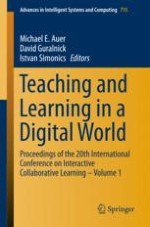This book gathers the Proceedings of the 20th International Conference on Interactive Collaborative Learning (ICL2017), held in Budapest, Hungary on 27–29 September 2017. The authors are currently witnessing a significant transformation in the development of education. The impact of globalisation on all areas of human life, the exponential acceleration of technological developments and global markets, and the need for flexibility and agility are essential and challenging elements of this process that have to be tackled in general, but especially in engineering education.
To face these current real-world challenges, higher education has to find innovative ways to quickly respond to them. Since its inception in 1998, this conference has been devoted to new approaches in learning with a focus on collaborative learning. Today the ICL conferences offer a forum for exchange concerning relevant trends and research results, and for sharing practical experience gained while developing and testing elements of new technologies and pedagogies in the learning context.
